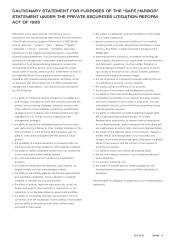Avon 2006 Annual Report Download - page 16
Download and view the complete annual report
Please find page 16 of the 2006 Avon annual report below. You can navigate through the pages in the report by either clicking on the pages listed below, or by using the keyword search tool below to find specific information within the annual report.PART I
Our ability to conduct business, particularly
in international markets, may be affected
by political, legal and regulatory risks.
Our ability to capitalize on growth in new international markets
and to maintain the current level of operations in our existing
international markets is exposed to risks associated with our
international operations, including:
• the possibility that a foreign government might ban or severely
restrict our business method of direct selling, or that local civil
unrest, political instability or changes in diplomatic or trade
relationships might disrupt our operations in an international
market;
• the possibility that a government authority might impose legal,
tax or other financial burdens on our Representatives, as direct
sellers, or on Avon, due, for example, to the structure of our
operations in various markets; and
• the possibility that a government authority might challenge
the status of our Representatives as independent contractors
or impose employment or social taxes on our Representatives.
For example, in 1998, the Chinese government banned direct
selling but, subsequently in April 2005, the Chinese government
granted approval for us to proceed with a limited test of direct
selling in certain areas. The Chinese government later issued
direct selling regulations in late 2005, and we were granted a
direct selling license by China’s Ministry of Commerce in late
February 2006, which has allowed us to commence direct selling
under such regulations. However, there can be no assurance that
these and other regulations and approvals will not be rescinded,
restricted or otherwise altered, which may have a material
adverse effect on our direct selling business in China. There can
be no assurance that we will be able to successfully transition
our business in China in connection with the resumption of
direct selling in that market and successfully operate using the
direct selling model currently in place or that may be sub-
sequently permitted in that market, or that we will experience
growth in that or other emerging markets. The introduction of
new channels in our business, such as the direct selling channel
in China, may also negatively impact existing sales. We may
encounter similar political, legal and regulatory risks in Central
and Eastern Europe, Latin America, Asia Pacific, and the Middle
East and Africa.
We are also subject to changes in other foreign laws, rules, regu-
lations or policies, such as restrictions on trade, import and
export license requirements, tariffs and taxes. In addition, we
face legal and regulatory risks in the United States and, in
particular, cannot predict with certainty the outcome of various
contingencies or the impact that pending or future legislative
and regulatory changes may have on our business in the future.
We are subject to other risks related to our
international operations, including
exposure to foreign currency fluctuations.
We operate globally, through operations in various locations
around the world, and derive approximately 75% of our con-
solidated revenue from our operations outside of the U.S. One
risk associated with our international operations is the possibility
that a foreign government may impose new currency remittance
restrictions. Another risk associated with our international oper-
ations is that the functional currency for most of our interna-
tional operations is the applicable local currency. Although we
implement foreign currency hedging and risk management
strategies to reduce our exposure to fluctuations in earnings and
cash flows associated with changes in foreign exchange rates,
there can be no assurance that foreign currency fluctuations will
not have a material adverse effect on our business, results of
operations and financial condition.
Third party suppliers provide, among other
things, the raw materials used to
manufacture our CFT products, and the
loss of these suppliers or a disruption or
interruption in the supply chain may
adversely affect our business.
We manufacture and package almost all of our CFT products.
Raw materials, consisting chiefly of essential oils, chemicals,
containers and packaging components, are purchased from vari-
ous third party suppliers for our CFT products. Almost all of our
non-CFT products are purchased from various suppliers.
Additionally, we produce the brochures that are used by Repre-
sentatives to sell Avon products. The loss of multiple suppliers or
a significant disruption or interruption in the supply chain could
have a material adverse effect on the manufacturing and pack-
aging of our CFT products, the purchasing of our non-CFT prod-
ucts or the production of our brochures. This risk may be
exacerbated by our recently announced strategic sourcing ini-
tiative, which is expected to shift our purchasing strategy toward
a global supplier orientation. Furthermore, increases in the costs
of raw materials may adversely affect our profit margins if we
are unable to pass along any higher costs in the form of price
increases or otherwise achieve cost efficiencies in manufacturing
and distribution.
The loss of or a disruption in our
manufacturing and distribution operations
could adversely affect our business.
Our principal properties consist of worldwide manufacturing
facilities for the production of CFT products, distribution centers
where offices are located and where finished merchandise is
packed and shipped to Representatives in fulfillment of their
























